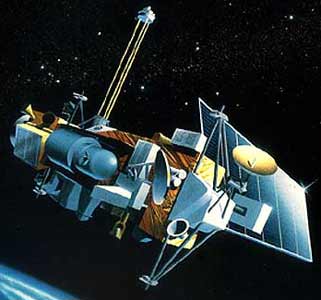Thank you very much for visiting Gunter's Space Page. I hope that this site is useful and informative for you.
If you appreciate the information provided on this site, please consider supporting my work by making a simple and secure donation via PayPal. Please help to run the website and keep everything free of charge. Thank you very much.
UARS

UARS [NASA]
UARS (Upper Atmosphere Research Satellite) was designed to study the physical and chemical processes occurring in the Earth's upper atmosphere (between 15 and 100 km). The vehicle provides measurements of atmospheric internal structure (trace constituents, physical dynamics, radiative emission, thermal structure, density) and measurements of the external influences acting upon the upper atmosphere (solar radiation, tropospheric conditions, electric fields). The specific UARS mission objectives are to study
- energy input and loss in the upper atmosphere,
- global photochemistry of the upper atmosphere,
- dynamics of the upper atmosphere,
- coupling among these processes,
- coupling between the upper and lower atmosphere.
It features following instruments:
- ACRIM II (Active Cavity Radiometer Irradiance Monitor)
- CLAES (Cryogenic Limb Array Etalon Spectrometer)
- ISAMS (Improved Stratospheric and Mesospheric Sounder)
- MLS (Microwave Limb Sounder)
- HALOE (Halogen Occultation Experiment)
- HRDI (High Resolution Doppler Imager)
- WIND II (Wind Imaging Interferometer)
- SOLSTICE (Solar-stellar Irradiance Comparison Experiment)
- SUSIM (Solar Ultraviolet Spectral Irradiance Monitor)
- PEM (Particle Environment Monitor)
UARS was originally to be launched in 1988, but was delayed due to the Challeger desaster to 1991. The UARS satellite was deactivated in late 2005 after 14 years of service. It reentered the atmosphere on 29. September 2011.
A second satellite, UARS-2, was to be launched one year after UARS in 1989 into a similar 600-km circular orbit, but with a higher 70° inclination angle. This mission was cancelled after the Challeger desaster.
| Nation: | USA |
|---|---|
| Type / Application: | Earth observation |
| Operator: | NASA |
| Contractors: | GE Astro Space, Fairchild (Bus) |
| Equipment: | ACRIM II, CLAES, ISAMS, MLS, HALOE, HRDI, WIND II, SOLSICE, SUSIM, PEM |
| Configuration: | MMS |
| Propulsion: | ? |
| Power: | Deployable solar array, batteries |
| Lifetime: | 3 years (design), 14 years reached |
| Mass: | 6795 kg |
| Orbit: | 585 km, 57° |
| Satellite | COSPAR | Date | LS | Launch Vehicle | Remarks | |
|---|---|---|---|---|---|---|
| UARS | 1991-063B | 12.09.1991 | CCK LC-39A | Shuttle | with Discovery F13 (STS 48) | |
| UARS 2 | - | cancelled | Va SLC-6 | Shuttle | with STS NN |
